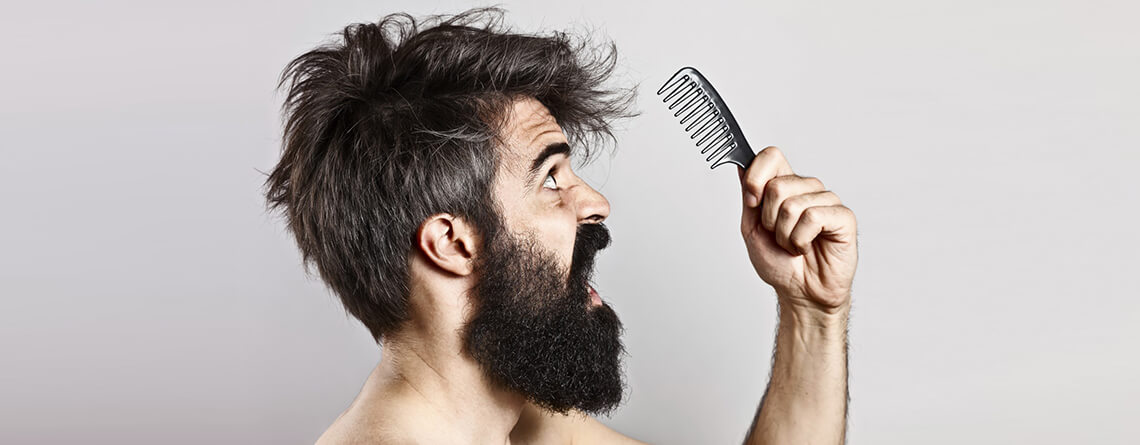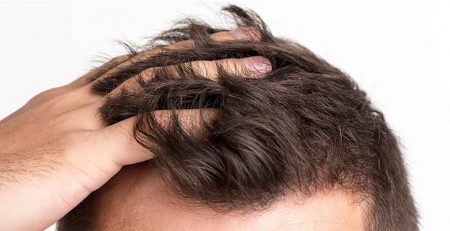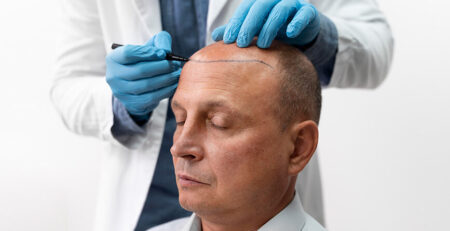The Complete Science of Hair Transplant
Male pattern baldness is a pervasive issue among men of all ages across the globe. Almost all men face this and accept is as nature’s work. While some who are not able to take the natural processes, opt for remedies such as hair transplant treatments or other temporary resolutions. Temporary solutions like applying medicated ointments, wearing wigs, hiding the bald areas with salon treatments etc., keep the problem at bay for shorter durations. On the other hand, hair transplant seems to have come across as a longer-lasting and possible solution for this pressing issue amongst men.
Hair transplant treatment must be performed at a well-equipped modern and sophisticated facility following the highest international standards. Also a qualified and experienced surgeon matters who can deliver the desired results that are natural stay for a substantial period.
To talk more about this procedure, let us first understand the male pattern baldness.
What is Male Pattern Baldness?
Hair loss in men can be caused by several factors, ranging from hormonal disorders to nutritional deficiencies. However, the most popular and common type of hair loss remains Androgenetic Alopecia, also called Male Pattern Baldness (MPB).
The male sex hormones are called androgens (the etymological source of androgenetic). Among their varied functions, ensuring and regulating hair growth is their job. The way these hormones operate within the body depends on genetic factors, making the condition androgenetic. Therefore, MPB presents as a hereditary problem. This means that hormones can remain at normal levels, and MPB can still happen due to the individual’s genetic makeup. The reason we emphasise this is to show how little control the man has over his MPB. Meanwhile, women, too, face Female Androgenetic Alopecia.
All this said, there is a combination of factors that contribute to baldness itself. While MPB may be genetic, this is not necessarily true of all baldness. Some common factors are:
- Hormonal Disorders
- Stress
- Nutritional Deficiencies
- Bacterial Infections
- Cancer
- Ageing
- Family History
Generally, it is observable that excessive hair loss gives way to balding. The best way – and only permanent way – to treat this is through hair transplant procedures.

Have questions or want to get started? We are ready to help you with a smile!
What is a Hair Transplant?
A lot of balding men search for “How to grow hair back” and get ads for toxic supplements that claim to have a high concentration of some chemical. Others try hair masks and salon treatments. Even more, men opt for toupees and wigs to cover up the bald spot. Are these effective options? No. No. And yes, but it can look very unnatural.
The main reason for hair transplant procedures is their guarantee at producing results. So what does this mean?
A hair transplant surgery restores hair to bald or thinning regions of the head. Its efficacy as a treatment is owing to the well-documented fact that hair follicles when transplanted to a different region, grow as they usually would. Therefore, hair transplant involves the transfer of the hair from the follicle to tip for best results.
There are three common techniques used in hair transplantation:
- Follicular Unit Transplant (FUT) or the Strip Method
- Follicular Unit Extraction Method (FUE)
- Advanced FUE Method (DHT)
While we will discuss each in further detail soon, there are also some other terminologies that you need to be acquainted with. The most important of these is the concept of the donor site.
What is a donor site?
The best hair transplant will give you successful and natural-looking results by taking hair from specific donor sites. As the name implies, donor sites are the areas from which hair is extracted and transplanted to the balding region. Most surgeons choose the back and sides of the scalp as donor areas. This is due to the abundance of hair found in these regions that is unaffected by the hormone Dihydrotestosterone (DHT).
This becomes the best hair transplant donor site because hair from these areas remains unresponsive to androgens, meaning it cannot start thinning or shedding again. Even in cases of total baldness, the patient has hair on the back of his head after transplantation that does not fall. These permanent zones have 6000-7000 hair grafts on average. It is noteworthy here that a regular hair graft consists of 1-4 strands, acting as a root for multiple strands. In India, MPB is a huge reality. Meanwhile, hair grafts typically have 1.7 hair strands. However, regardless of transplant size, hair once transplanted from a region unresponsive to androgens continues being unresponsive post-transplant.
This, therefore, becomes a permanent method concerning how to grow hair back. This then brings us to the next point – why are hair transplants a thing?
Why Patients Use Transplants for How to Grow Hair Back
Apart from its permanent, non-falling nature, this remains the best hair transplant procedure due to its ease of transfer. This ease is further exemplified in specific situations of patient discomfort.
The main reason, therefore, that several people face the hair transplant cost in Delhi is an embarrassment. Balding, especially premature and the way it does in PMB, can cause a lot of self-conscious behaviour if the patient is still coming to terms with it. Therefore, transplants become popular choices among such patients who want fuller heads of hair (and rightfully so).
What is the Hair Transplant Cost in Delhi
Although we touched on this, understanding the various factors that go into determining the price of hair transplant procedures is essential. Patients need to understand what a procedure does on every front, including the financial front. Understanding the levels of quality also ensures that the patient gets the best hair transplant for their needs. This way, the results meet their expectations much better and fulfil them more. The ideal standards to have during such procedures, therefore, are:
A Board-Certified Surgeon
Ensuring your surgeon has the necessary expertise to deliver your desired results adequately is important. Choosing a board-certified surgeon who adheres to international standards of patient care maintains this standard better. Choosing someone with glowing patient reviews gives you further assurance that they will understand your plight and do everything in their power to alleviate any suffering you may have. While a surgeon with such refined experience may have a higher price tag, costs are just numbers when you look at the benefits of eternal happiness.
A Well-Equipped Centre
Having a centre that can meet your needs with equipment and infrastructure is the next requirement. If your surgeon claims to be well-versed in the latest techniques and you choose them due to this, they need to be able to perform these techniques. The centre needs to be conducive to both yours and your surgeon’s needs. Additionally, the hygiene and general care levels in a centre can make or break patient experience. Giving you the highest quality care involves attentive centres that meet your specifications and quality requirements. Therefore, combined with a board-certified surgeon, these determine how excellent hair transplant procedures in Delhi will be.
An Expertly-Wielded Technique
Finally, when choosing a surgeon, presumably technique is scrutinised. If not, you need to ensure that your surgeon has the latest techniques mastered. While these increase the hair transplant cost in Delhi, they have a much better pay-off in the long run, with results looking very natural and appealing to the patients. Expertly wielding techniques also demands a keen understanding of the patient’s needs and choosing the right technique that would benefit them most. The great thing about modern-day hair transplant procedures is that one size does not have to fit all. Surgeons continuously personalise treatments for better results – with visible success. Therefore, you need a surgeon who prioritises success in the same way.
While having such standards may be expensive, this is with good reason. The superior results afforded by superior standards remain unmatched. Ensuring you actually get the best hair transplant demands such standards and you cannot hold it against yourself for maintaining them. Additionally, having high standards and a resulting high-quality procedure further confirms that the procedure is done right, with natural-looking results.
This finally brings us to the hair transplant procedures.

How the Best Hair Transplant Procedures are Performed
We can now explore the various hair transplant procedures. But first, let us discuss the general procedure, especially in relation to the donor site and the kinds of grafts.
Hair transplant involves removing hair grafts from the hair-bearing part of the scalp and relocating them to a bald or thinning area. The grafts may differ in size and shape:
- Strip grafts are long and thin, containing 30-40 hairs
- Round-shaped punch grafts containing 10-15 hairs
- Slit grafts contain 4-10 hairs
- Smaller mini-grafts contain 2-4 hairs
- Micro-grafts contain 1-2 hairs
It can take several sessions to achieve truly satisfactory results and up to 2 years before the final results are visible. Healing intervals are provided for a few months between sessions, and the amount of coverage a patient gets depends on their hair colour and texture. The number of grafts transplanted also varies with mini and micro-grafts, often requiring more sessions depending on the individual.
Before the procedure, the donor area is trimmed to enable accessibility to the grafts. Punch grafts require special tube-shaped, carbon steel instruments that can punch the graft out of the donor site and place it in the area needing coverage (generally used in the frontal hairline). These are often closed with a single stitch.
Other types of grafts require scalpel-based removal and tiny holes or slits in the scalp where grafts can be transplanted. Your surgeon might also use saline solution to maintain skin strength. The donor site is then closed with stitches which leave a small scar, usually concealed by the surrounding hair.
Grafts are generally placed about 1/8 of an inch apart. These gaps are closed in later sessions with additional grafts. These measures contribute to natural-looking results by ensuring that your hair grows in the right direction while the hair growth in the donor site continues naturally, too. After the grafting and transplanting are complete, the scalp is cleaned and covered with gauze, with a pressure bandage often provided for a day or two.
While these steps form the base for all the hair transplant procedures, there are specific, sophisticated methods that contribute to better results. These include:
- Follicular Unit Transplant (FUT) or the Strip Method
- Follicular Unit Extraction Method (FUE)
- Advanced FUE Method (DHT)
Let us explore each one in-depth.
Follicular Unit Transplant (FUT) the Strip Method
FUT is the most popular procedure for transplanting hair from areas at the back and sides of the head to the balding regions. The patient has the procedure under anaesthesia, and the surgeon removes tissue strips from the donor area. The precision afforded by removing strips ensures that the following dissection into individual follicular units is much better. This dissection is performed under a microscope, prepping the strip for transplant by turning it into grafts.
After this, the surgeon makes tiny holes in the scalp. The newly created follicular unit grafts are placed into these holes carefully, and the donor area is sutured. Dr Rajat Gupta uses a specialised plastic surgery technique called Trichophytic Closure during this suturing. A thin strip from the outermost layer of skin (known as the epidermis) is removed before closure. This is removed from one side of the wound. The follicles lying under the scar caused by the incision grow, camouflaging the scar.
Follicular Unit Extraction Method (FUE)
While the strip method involves removing a strip and cutting it into follicles, this procedure involves directly extracting follicles. Performed after the donor site’s hair is completely trimmed, the skin around each follicular unit is superficially incised through a motorised punch. The unit is then directly extracted from the scalp through a combination of forceps traction and pressure on the surrounding area.
Since the units are directly removed, the recovery time from FUE is much lower than FUT. The scarring from FUE is also practically invisible since the puncture wounds are too tiny to be visible to the naked time. This further contributes to a recovery period of fewer than seven days. However, the FUT method can get more grafts than FUE. FUE allows for 2000-2700 graft extraction while FUT allows for 2600-3000 (sometimes more). When used together, 3500-4000 grafts can be transplanted by two sessions. The number of required grafts depends on the surgeon’s advice.
Direct Hair Transfer (DHT) (Advanced FUE Method)
Direct Hair Transfer is a more sophisticated, precise and advanced form of the FUE technique. Unlike the traditional FUE method, DHT involves direct extraction of individual follicular units from the donor area without any motorised help. Rather, the surgeon uses a manual extractor and uses the transplanter (a patented device) for the subsequent implantation. This implantation does not require the creation of recipient holes.
The hair extracted through this method can be implanted into the beard, chest or pubic regions. Depending on the location of placement, the angle, depth and direction of the grafts, your surgeon determines how best to give you 100% natural results. The out of body time for each graft also decreases substantially, adding to the advantages of the DHT method and the manual punch. Additionally, there is less damage when performed manually due to the absence of vibration and heat. The decreased out of body time also causes greater density with more successful results compared to the FUE method. The hairline also looks completely natural.
Recovery and Results
There are several benefits to hair transplant procedures. While opting for a high-quality procedure may increase the hair transplant cost in Delhi, the results can be very desirable with an easy recovery.
Therefore, here are some points to note about your results and recovery timeline:
- This procedure is an out-patient procedure
- All the transplanted hair falls off during the first month after the procedure so that new hair can grow in its place.
- The new hair begins regrowing after 1-2 months, with a 1cm average growth rate per month.
- This growth rate means you only appreciate the results after 8-10 months.
- There may be some swelling, bruising and discomfort for the first 24-48 hours depending on the procedure and extent of transplant. This completely goes away as recovery continues.
- The patient can resume daily activities from the day after surgery.
- You must, however, avoid sudden movements, lifting weights for at least two weeks.
- After the stipulated recovery time, you will have a full head of hair that will not fall. You can shampoo, cut, style, and even colour it with no adverse effects!
These are the effects of the best hair transplant in Delhi – you should not settle for anything less.
Conclusion
Although the hair transplant cost in Delhi depends on many factors, suffice to say that patients experience a massive confidence boost after undergoing the procedure. Therefore, if you are wondering how to grow your hair back, making an investment in the best hair transplant procedures is a sure-fire way of ensuring you regain a full head of hair.
Dr Rajat Gupta, the board-certified surgeon at RG Aesthetics, holds the profound knowledge of medical restoration sciences. Trained in international standards of surgical methods and patient care, he understands the needs of his patients; he commits to producing entirely natural-looking results through safe hair transplant procedures with minimal scarring!
Dr. Rajat Gupta
MBBS, MS, DNB(Gen. Surg.),
DNB (Plastic Surgery)
Dr. Rajat Gupta is a board certified plastic surgeon in India with 10 years of experience to back his expertise in the domain of aesthetic surgeries.
Having completed his training from Maulana Azad Medical College and equipped with a thorough understanding of aesthetic needs of people, Dr. Gupta strives to offer the best remedies and cosmetic procedures outfitted with the latest technology to the aspirants in India and across the globe. To book an appointment, call: +91-9251711711 or email: contact@drrajatgupta.com








